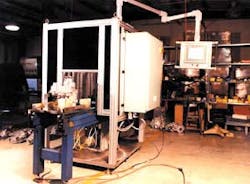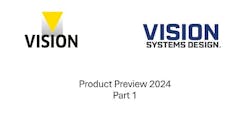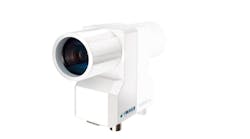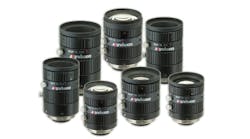SPOTLIGHT ON MACHINE VISION: Image Analysis
Automated machine-vision inspection system checks four different automobile transfer cases per minute for holes, threads, and flanges.By Bob Emery and Ben Friend
When shifted into all-wheel drive, four-wheel-drive vehicles use gearing assemblies known as transfer cases to transmit power from the transmission to the rear differential gearbox. To manufacture these transfer cases, multiple assemblies often run on the same production line. Because some of the assembly differences are subtle, human inspectors can overlook some incorrect assemblies, resulting in an improper assembly being shipped to a customer. In addition, critical parts are sometimes improperly placed, omitted, or defectively assembled. Moreover, transfer-case manufacturing often occurs 24 hours a day/seven days a week, with different inspectors assigned to different shifts, further increasing quality-control problems.
A Midwestern manufacturer of transfer cases builds four types of cases on a single, palletized assembly line. Differences might include dissimilar lower case assemblies, number of threaded holes, flange thicknesses, and bolt hole diameters. Because of pallet differences, transfer-case placement can vary as much as 0.1 in. from pallet to pallet. Coupled with the small differences that differentiate the assemblies, location of critical features, and the number of features that need inspection, this 0.1-in. distance makes automation of the inspection procedures a formidable task.
Automated solutions
To correct both the assembly and the human inspection problems with an automated machine-vision inspection system, the transfer-case manufacturer called on AutomationSolutions (Englewood, CO) to produce a system capable of inspecting four transfer cases per minute. The system is required to check the top of the transfer case to ensure that four bolt holes are in place and that the holes are either 8 or 10 mm in diameter, to verify that threads are present, and to accurately measure a 0.25-in. adapter flange difference from the outside edge of the case. In addition, the bottom of the transfer case must be checked to measure an output flange thickness of between 3/8 and 2 in. Because no barcoding identifies which assembly is being inspected, the bolt holes of each transfer case are used as an identifying feature.
To implement the automated inspection process, the inspection station had to fit over an existing pallet lift station that incorporates a 4 x 2-ft pallet lift station. Furthermore, operator accessibility was important. For example, the operator interface station must be accessible from both sides of the line. All these requirements, coupled with future expandability to integrate barcoding systems, ready access to input/output (I/O) signals, and inspection adjustable decision limits established as acceptance/rejection criteria, presented a daunting design and integration task.
FIGURE 1. In the design of the transfer-case inspection system, several off-the-shelf components were used in a PC-based subsystem for motion control and machine vision. The PC includes ASIC-200 Soft Control software that sequences the inspection station operation and includes the input to the vision system to start the inspection. Once the transfer case is sensed to be in place, four CCD cameras are sequenced by a PCI-based machine-vision system to take all the preprogrammed images.
To cover all the requirements, an open-control approach was determined to be the most cost-effective and more flexible than proprietary products. Further, the cost of integration was of considerable concern, since delivery requirements were short (on a comparable basis with other systems of similar integration levels).
Open architecture
To meet these system requirements, AutomationSolutions developed a PC-based machine-vision and control system using a panel-mounted PC from Granite Microsystems (Mequon, WI). To perform programmable logic control (PLC), an ISA-bus-based DeviceNet controller from TRS Fieldbus Systems (Troy, MI) was integrated to interface to the valves and sensors that controlled the sequencing of the parts through the inspection station.
The PC includes ASIC-200 Soft Control software from Xycom Automation (Saline, MI); this software sequences the inspection station operation, which includes the input to the vision system to start the inspection. Based on the IEC-61131 international standard of the International Electrotechnical Commission (Geneva, Switzerland) and supported by the PLC Open Association (Barrie, Ontario, Canada), IEC-61131 specifies the syntax and semantics of a unified suite of programming languages for programmable controllers.
The ASIC-200 package provides drivers for the Fieldbus I/O, which interfaces to the vision system and the screen-building capability for the human-machine interface (HMI). Based on customer selection, DeviceNet was the Fieldbus protocol of choice. Because of the desire for machine-mounted I/O, the I/O modules from TRS Fieldbus Systems were selected for their compactness and DeviceNet interface capability (see Fig. 1). Easy access and clear visibility were also critical for I/O signal selection.
FIGURE 2. Using a Manual Control screen allows an operator to monitor all of the sensors used in the vision inspection system and control the transfer-case lift mechanism (top). For setup purposes, the Test Setup screen allows the operator to access live camera images from all of the cameras in the transfercase inspection system (bottom).
After the transfer case is sensed to be in place, four CCD cameras from Sony Electronics (Park Ridge, NJ) are sequenced by a PCI-bus-compatible 900 Series Machine Vision Engine vision processor from Cognex Corp. (Natick, MA) to take all the preprogrammed images. Vision-system settings and parameter adjustments are then shown on the user interface as manual operations, vision overrides, and error messages.
The Cognex 900 Series Machine Vision Engine provides four-camera capability, which can be increased to 16 though multiplexing. The choice of camera location and lighting were based on a thorough installation site survey and a subsequent engineering study of many sample parts for each assembly, including some with known flaws and others with marginal discrepancies.
The bolt-hole-diameter inspection determines which part is in the inspection station. Therefore, it is the most critical inspection task and requires the best resolution possible that is consistent with the field of view (FOV) available. Using a Sony CCD camera and a FOV of approximately 180 mm, a system resolution of ±0.3 mm was obtained. For a 2-mm-diameter deviation in hole diameter, this resolution provided approximately six pixels to decide which assembly is located at the station. To assure vision integrity, a single iteration Sobel filter averages the edge pixels over a nine-pixel area to filter edge-pixel noise.
The bottom pan flange recognition measurement allowed for a small FOV (less than 6 mm). Therefore, a larger number of pixels were available to detect the ±0.25-in. difference in flanges.
To measure the correct output flange, the camera was mounted underneath the lifted assembly to ensure a proper view. With the FOV available, more than adequate resolution was obtainable. More than 60 pixels were available to determine the 3/8-in. difference in output flange thickness.
To inspect the presence or absence of hole threads and broken taps, which can fill a tapped hole, lighting was critical because of limited access to the top surface of each hole. After an evaluation study, a standard ringlight that was being used for other inspections was incorporated, but it was not the optimum solution. Although the optimum solution would be to use structured lighting, time and space did not allow this technique to be immediately implemented. However, repeatability was obtained by taking up to ten images in the allotted time and determining the best decision from a more extensive amount of data.
Operator functions
Conventional operator functions, including manual machine operation, are provided through the ASIC-200 HMI capabilities and presented on a Xycom Automation touch-screen operator-interface terminal. However, intermingled with the machine operation functions are several selected machine-vision screens that are accessible through security levels.
Other necessary functions include selection of screens such as Manual Control and Test Setup (see Fig. 2). In operation, the inspection process can be immediately bypassed, should a vision malfunction occur that would require such action, using a "Bypass Inspection" operator input. Also, an assembly can be re-inspected should the operator choose to do so using a "Manual Inspection" operator input that allows the operator to inspect the assembly before it is moved from the station.
Other machine-vision screens are available but only through a security layer, which limits access to qualified, trained personnel. These screens provide access to parameter limits that are used to determine acceptance. All screens were configured using Visual Basic extensions from the Xycom Automation ASIC-200 soft control within the Granite MS PC and delivered to the Xycom touch-screen, which functions from a pendant attached to the machine frame.
The inspection-station acceptance process (before installation) was based on randomly processing known good assemblies mixed with various known flawed assemblies of all four transfer-case assembly types. Several hundred station cycles were processed to assure 100% operation.
Once shipped to the plant site, the only time allotted for shutdown was the third shift on a Sunday night. The station had to be installed and running before the morning shift began. Although it was operating after this first installation effort, subsequent visits were necessary to fine-tune the vision parameters based on new process variables that were not available on the parts run during acceptance. This is typical of any in-line inspection process when more than one assembly is involved.
After two years of operation, the system has been upgraded to incorporate barcode reading. Under PC-based control, the barcode interface card can be inserted into the PC (using a serial or Ethernet protocol). Using the generic dual-port RAM driver available in ASIC-200, barcode information can easily be accessed. Future expansion plans include uploading the flaw data to a local-area network upon request. With all assemblies coded and networked, rejection data can be collected and uploaded through the enterprise for real-time audits off-line.
The key to implementing this complex vision platform, which also included several customer changes during systems integration, was the use of nonproprietary, open-control technology based on AutomationSolutions Open Architecture Strategy. This technology also allows for easy future expansion. Such expansion could include more cameras, motion control to move cameras, local or remote I/O expansion, barcode input, HMI expansion, SPC data, and networking based on future plant and customer requirements.
BOB EMERY is automation resource center manager and BEN FRIENDis field automation engineer at Automation Solutions (Englewood, CO 80112).
Company InformationAutomationSolutionsEnglewood, CO 80112Web: www.automationsolutions.comCognex Corp.
Natick, MA 01760
Web: www.cognex.com
Granite Microsystems
Mequon, WI 53092
Web: www.granitemicrosystems.com
IEC
Geneva, Switzerland
Web: www.iec.ch
PLC Open Association North America
Barrie, Ontario, Canada
Web: www.plcopen.org
Sony Electronics Inc.
Park Ridge, NJ 07656
Web: www.sony.com/videocameras
TRS Fieldbus Systems Inc.
Sterling Heights, MI 48313
Web: www.trs-fieldbus.com
Xycom Automation Inc.
Saline, MI 48176-1292
Web: www.xycom.com







